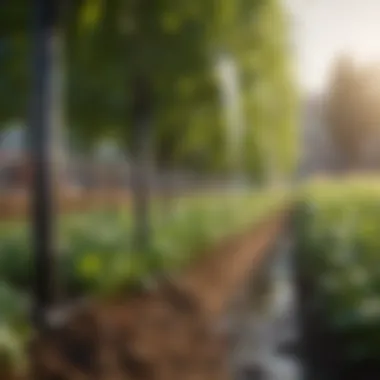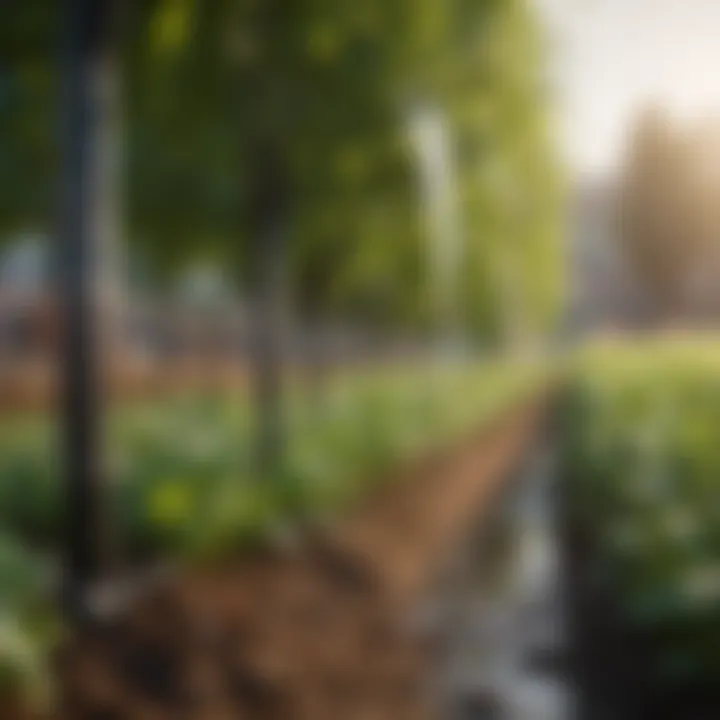Maximizing Efficiency in Drip Irrigation for Grow Bags


Intro
As agriculture continues to evolve, farmers and gardening enthusiasts find themselves at the crossroads of tradition and innovation. One notable advancement in sustainable farming practices is the integration of drip irrigation systems with grow bags. Drip irrigation, a method that delivers water directly to plant roots, coupled with grow bags, provides numerous advantages in terms of water conservation, nutrient delivery, and plant health. The efficiency of these combined systems makes them an appealing choice for anyone looking to optimize their growing environments.
The essence of this article lies in its comprehensive approach towards enhancing the efficacy of drip irrigation tailored specifically for use with grow bags. It will not only delve into the fundamental principles of drip irrigation and the distinct requirements of plants within grow bags but also share actionable techniques for setting up and maintaining these systems.
Through investigating critical topics such as water conservation methods, appropriate fertilizer application, and troubleshooting common challenges, readers will arm themselves with valuable insights. Thus, this guide serves as a vital resource for both novices and seasoned horticulturists aiming for sustainable cultivation solutions.
Key Concepts and Terminology
Understanding the lingo of drip irrigation and grow bags is pivotal for successful application.
Basic Definitions
- Drip irrigation: A precise watering system that delivers water to the roots of plants through a network of pipes. It minimizes water wastage by providing only what plants need.
- Grow bags: Lightweight, breathable bags made of fabric or other materials that allow roots to grow while offering enhanced aeration and drainage compared to traditional pots.
Historical Context
Drip irrigation has its roots way back in ancient civilizations like the Mesopotamians and Egyptians, who innovated methods to harness water more efficiently for their crops. Fast forward to the modern era, the 1960s saw a major evolution with the development of plastic tubing, which enhanced the accessibility and affordability of drip systems. Grow bags entered the scene in the late 20th century, allowing gardeners to overcome traditional limitations of size and mobility in plant growth.
Recent Innovations and Trends
Looking at the present, the fusion of drip irrigation techniques with grow bag usage is rapidly advancing, currently grounded in sustainable agricultural practices.
Technological Advancements
Recent years showcased innovative products like smart drip systems that utilize sensors to determine soil moisture levels—automatically adjusting water delivery based on the plants’ needs. Mobile apps further aid in the management of irrigation schedules and monitoring system performance.
Sustainable Practices
Sustainability is at the heart of contemporary agricultural trends. Choosing organic fertilizers and utilizing rainwater harvesting systems alongside drip irrigation not only conserves resources but also promotes healthier plant growth.
Practical Applications and Techniques
When it comes down to practical applications, several strategies can help optimize your drip systems for grow bags.
Step-by-step Guides
- Assess your space: Evaluate the area where you plan to set up the drip system and decide on the number of grow bags.
- Select your components carefully: Invest in high-quality drip tubing and emitters to ensure a reliable system.
- Install the system: Lay out the tubing beside the grow bags, making sure each bag has a dedicated emitter. Connect everything to a water source.
- Adjust water flow: Monitor the flow rates to provide adequate moisture without over-saturating the soil—the key balance for successful growth.
Case Studies
Consider the case of a small-scale organic farm in California that introduced drip irrigation to their grow bag setup. They reported a 30% reduction in water usage and a notable increase in yield quality. By sharing techniques like layering soil mediums for better aeration and moisture retention, it became evident how essential proper setup can be in maximizing benefits.
Using these systems not only supports plant vitality but also builds environmental resilience, ensuring the future of agriculture is as bright as it can be.
Understanding Drip Irrigation
When it comes to planting, irrigation systems can make or break the health of your plants. Understanding drip irrigation serves as the backbone of this article, laying the foundation for how you'll optimize your grow bags. As the world shifts towards more efficient farming practices, knowing the principles of drip irrigation is crucial for farmers and gardening enthusiasts alike.
Drip irrigation is more than just a method; it’s a philosophy of resource conservation and plant health. The precise nature of drip systems allows you to supply water directly to the root zone of the plants, minimizing evaporation and maximizing efficiency. It's like giving your plants a perfectly tailored drink when they need it most.
Definition and Principles
Drip irrigation is defined as a low-pressure system that delivers water directly to the roots of plants through an intricate network of tubing and emitters. This system uses a timer or pressure-regulating valves to ensure that water is applied consistently. The principle is simple: small amounts of water are applied frequently, allowing the soil to absorb moisture without becoming oversaturated.
Several components work together in a drip irrigation system:
- Tubing: The main arteries transporting water. Different diameters can affect the flow rate.
- Emitters: These are the delivery systems that provide the exact amount of water directly to the plant roots.
- Filters: They prevent debris from clogging emitters, thus ensuring optimal water flow.
- Pressure regulators: They control the water pressure, keeping it at a level that the emitters can handle without malfunctioning.
Advantages of Drip Irrigation
The benefits of drip irrigation are manifold and quite noteworthy. Here are some key advantages:
- Water Conservation: It minimizes water wastage. With the threat of droughts looming globally, using less water is not just a choice; it's a necessity.
- Increased Yield: By delivering moisture precisely where it’s needed, crops receive the right amount of water for optimal growth.
- Reduced Weed Growth: Since water is only supplied to the plants, surrounding weeds receive less moisture, reducing their growth.
- Disease Prevention: Watering the soil instead of the plant foliage minimizes the chances of fungal diseases.
Comparison with Other Irrigation Systems
To understand the full scope of drip irrigation, it’s helpful to compare it with other common methods like sprinkler systems and traditional surface irrigation.
- Efficiency: Drip irrigation is well-known for its efficient water use, often 30-50% more effective than sprinkler irrigation.
- Targeting: While sprinklers cover a wide area, drip irrigation zeroes in on the roots, ensuring that the vital parts of the plant are well nourished.
- Labor Costs: Though initial setup may be more labor-intensive for drip systems, ongoing maintenance costs are usually lower than those of traditional methods.
- Customization: Each plant’s water needs can be adjusted with drip systems, while sprinklers are generally uniform across a larger area.
Drip irrigation offers a targeted approach to watering that aligns perfectly with the specific needs of plants grown in grow bags.


As you can see, grasping the fundamentals of drip irrigation not only enhances the health of your plants but also promotes sustainable practices that are crucial in today’s agricultural landscape. This understanding lays the groundwork for further discussions regarding grow bags and their compatibility with drip irrigation systems.
Prelude to Grow Bags
In the realm of modern agriculture, understanding the tools and techniques available can significantly elevate one’s gardening game. One such tool is the grow bag. These bags are more than just simple containers; they represent a forward-thinking approach to growing plants. By delving into what grow bags are and their unique benefits, we can see why they are becoming increasingly popular among both hobbyists and professionals.
What Are Grow Bags?
Grow bags are essentially fabric containers designed for growing plants. Unlike traditional pots, grow bags are made of breathable material that can vary in composition, often using materials like geotextiles or recycled plastics. Their lightweight nature makes them easy to maneuver and position in different locations. This versatility often proves beneficial for urban dwellers with limited space but a passion for gardening.
The structure of grow bags promotes air circulation to the roots, allowing for healthier growth. When roots reach the sides of the bag, the air exposure encourages pruning – a process where roots die back instead of circling endlessly, which is common in plastic pots. This air-pruning is essential for developing a robust root system, leading to more vigorous plant growth.
Benefits of Using Grow Bags
Grow bags come with a plethora of benefits that make them a smart choice for cultivation:
- Enhanced Drainage: Their design ensures that excess water drains away quickly, reducing the risk of waterlogged soil and root rot.
- Temperature Regulation: The breathable fabric allows for better temperature control, keeping roots cooler in the summer and warmer in the winter compared to traditional pots.
- Portability: Given their lightweight nature, moving grow bags around is a breeze. This can be helpful for providing optimal light conditions or protecting plants from harsh weather.
- Soil Health: They promote healthier soil through aeration and improve nutrient absorption, helping to enhance plant vigor.
As you can see, the grow bag is not just a container; it's a well-thought-out solution that addresses some of the common challenges in gardening.
Ideal Plants for Grow Bags
For those curious about what can be grown in these innovative containers, the options are quite vast. Many vegetables and flowers thrive in grow bags, but some plants, in particular, take well to this setup:
- Tomatoes: They do particularly well, benefiting from adequate drainage and the air circulation offered by grow bags.
- Peppers: Both sweet and hot varieties can flourish in the warm environment of a grow bag.
- Herbs: Basil, cilantro, and parsley enjoy the light and aeration that grow bags provide.
- Root Vegetables: Carrots and radishes can grow comfortably, as long as the bags are deep enough.
"The right plant in a grow bag can bring about an extraordinary garden experience, combining ease with productivity."
Being mindful of the specific needs of each plant is key to success. In essence, by utilizing grow bags for these plants, gardeners can maximize yields while enjoying a manageable and efficient growing process.
Setting Up a Drip Irrigation System for Grow Bags
Setting up a drip irrigation system for grow bags is a pivotal aspect of ensuring your plants thrive without the fuss of traditional watering methods. This section delves into why it's crucial to establish an efficient, reliable irrigation system specifically designed for the unique requirements of grow bags.
When you think about it, every drop counts, especially in the world of agriculture where water resources can be limited. Drip irrigation, combined with grow bags, creates an environment where plants can receive consistent moisture. This leads to healthier, more vibrant plants. Not only does it save water, but it also minimizes the risk of overwatering, which can often lead to root rot — a gardener's worst nightmare. Additionally, this method allows nutrients to be delivered right to the root zone where they're needed most, promoting stronger growth.
Materials Needed
To kick off the installation of your drip irrigation system, you need to gather the necessary materials. Having everything at your fingertips helps in streamlining the setup process. Here’s a handy list of what you’ll require:
- Drip Tubing: This is your main line that will carry water to your grow bags. Choose a size that fits your setup.
- Emitters: These are the little devices that drip water slowly to your plants. They come in different flow rates, so pick what fits your plants’ needs best.
- Connectors: To link the tubing sections together and to the water source.
- Filter: Important for keeping your system clean; filters prevent debris from clogging your emitters.
- Pressure Regulator: Essential for ensuring that the water pressure is appropriate for your system. Too much pressure can ruin the emitters.
- Timer (optional): A timer can automate the watering process based on your preferences.
- Fittings and stakes: To secure your tubing in place and manage how the water is distributed.
Assembling these materials before diving into installation can save time and headaches later on.
Installation Process
Now comes the fun part: installing your drip irrigation system! Follow these straightforward steps:
- Plan Your Layout: Before laying any tubing, visualize where you want your grow bags arranged. The layout will dictate how long your drip lines need to be.
- Install the Main Drip Line: Start from your water source, laying the drip tubing towards your grow bags. Ensure it’s secure and won’t move around.
- Attach Emitters: Depending on your plants, space the emitters about 12-18 inches apart along the tube. Adjust based on the water needs of each plant species.
- Connect Other Components: Attach the filter and pressure regulator directly to the water source. This is crucial for ensuring your emitters function properly without clogging.
- Test the System: Once everything is connected, turn on the water and check each emitter. Make sure they’re all dripping as intended.
"Taking the time to plan and test can save both water and your plants’ health in the long run."
Determining Water Requirements
Every plant has unique water needs, and understanding these requirements is vital to the success of your irrigation system. Several factors influence how much water your plants truly need:
- Plant Type: Different species have different thirsts. Some like it moist, while others prefer to dry out a bit between watering.
- Climate: Warmer weather may require more watering, while cooler weather may call for less.
- Growth Stage: Young plants often require less water than those in full bloom.
- Soil Type: Well-draining soils might need more frequent watering than heavier soils that hold moisture longer.
A good rule of thumb is to start with a general recommendation and then monitor your plants. A soil moisture meter can be a handy tool to have in your kit; it helps you gauge when it's time to water.
By knowing your plants’ needs, adjusting your system and watering schedule will be child's play, leading to lush growth and fruitful yields.
Water Management Techniques
Effective water management is the cornerstone of successful drip irrigation in grow bags. This aspect is not just about getting water to the plants; it encompasses a variety of approaches and practices that ensure optimal water use while maximizing plant health and minimizing waste. With climate change exacerbating water scarcity, adopting these techniques isn’t merely beneficial—it’s essential.
Scheduling Irrigation
Getting the timing right for irrigation is key to keeping your plants thriving. Scheduling involves determining how frequently and when to water your plants, taking into account factors such as the weather, plant growth stages, and soil characteristics. It’s not a one-size-fits-all situation; different plants have varying water needs.
- Consider the climate: During hotter months, plants tend to lose moisture faster. A common practice is to water early in the morning or late in the afternoon to reduce evaporation losses.
- Growth stage: Newly planted seedlings generally need more frequent watering than mature plants, which can tap into deeper moisture reserves.
- Soil type: Well-drained soils may require more frequent, shorter irrigation sessions compared to heavier soils that retain moisture.
By tailoring your irrigation schedule, you’ll enhance water efficiency while promoting robust growth.


Monitoring Soil Moisture
Soil moisture monitoring is an indispensable element of water management. Understanding when and how much water to apply can directly impact plant health and growth rates.
- Soil moisture sensors can give a real-time readout of moisture levels, ensuring you don’t over or under-water your plants. These gadgets come in varied options, from simple probes to more advanced systems that integrate with your irrigation setup.
- Manual checks can also be useful—simply sticking your finger into the soil a couple of inches can provide insight. If it feels dry at that depth, it’s time to water.
Proper monitoring allows one to cater to the specific moisture needs of different plants, ultimately leading to healthier crops and higher yields.
Adjusting Water Flow
Adjusting the water flow in your drip irrigation system isn’t just about speed; it’s about precision. Too much water too quickly can lead to waterlogging, whereas too little can leave plants thirsty.
- Emitter types: Drippers come with different flow rates. Choosing the right emitter type is crucial. Low-flow emitters are suitable for plants with lower water needs, while those that require more can benefit from higher flow options.
- Zoning your system: Consider zoning your drip system so that you can cater to plants with different needs simultaneously. This allows you to adjust flows according to varying requirements without compromising the overall efficiency of your irrigation.
The ability to manipulate water flow at a granular level ultimately aids in crafting an efficient watering plan that is dynamic and responsive to changing conditions.
Nutrient Delivery Through Drip Irrigation
Understanding how to deliver nutrients efficiently through a drip irrigation system is central to achieving optimal plant health in grow bags. Utilizing precise nutrient delivery means not just watering plants, but giving them the essential elements they need to flourish. A targeted approach to nutrient application ensures that every drop counts, fostering robust growth and maximizing yield while minimizing waste and environmental impact.
Choosing the Right Fertilizers
Selecting the appropriate fertilizers is crucial when it comes to drip irrigation. Not all fertilizers are created equal. You should consider the N-P-K ratio (Nitrogen-Phosphorus-Potassium) which indicates the nutrient distribution and helps tailor your approach based on the plant's growth stage.
For instance, young plants benefit from a higher nitrogen ratio, stimulating leaf and stem growth. Conversely, when the plants are blooming, a balanced or phosphorus-rich fertilizer becomes more suitable to enhance flower development. Here are some key points to keep in mind:
- Organic vs. Synthetic: Organic fertilizers like compost tea can be gentler on plants and boost soil microbe activity, while synthetic options might provide quick results.
- Release Rate: Granular fertilizers can release nutrients over time, while liquid fertilizers often act fast. Knowing the demands of your cultivated plants helps you choose wisely.
Injectors and Fertilizer Application
To efficiently introduce fertilizers through your drip system, injectors or fertilizer systems play a pivotal role. An injector functions as a gateway, allowing nutrient solutions to enter the irrigation stream. Proper calibration is essential to avoid over- or under-fertilization.
- Venturi Injectors: This type of injector uses water pressure to draw concentrated fertilizers into the system. It’s simple to install but requires a solid understanding of your water pressure to set correctly.
- Positive Displacement Injectors: These allow more precise control over nutrient dosing but are typically more expensive.
When applying fertilizers, be mindful of these considerations:
- Dilution: Always dilute your fertilizers adequately to prevent burning roots.
- Compatibility: Some fertilizers don’t mix well, leading to clogs and possible damage to your system.
Timing of Nutrient Delivery
Timing is everything in agriculture, and nutrient delivery via drip irrigation is no exception. Proper scheduling can make all the difference in how well your plants absorb the nutrients provided. Here’s what to think about when timing your fertilization:
- Growth Stages: Align nutrient delivery with critical growth periods. For example, sending out nutrients during early morning, when plants are actively absorbing moisture, can enhance uptake.
- Watering Schedule: If you’re watering every other day, consider incorporating fertilization into the first cycle to ensure nutrients are available in the soil when plants need them.
- Environmental Factors: Temperature and humidity can affect nutrient absorption. Hot, dry conditions might necessitate more frequent but lighter doses.
Properly managing nutrient delivery through drip irrigation not only boosts plant wellbeing but also conserves valuable resources, providing a sustainable edge to your gardening practices.
In summary, effective nutrient delivery is not merely about adding fertilizers to water; it is about a systematic approach where timing, type, and technology converge to promote healthy, flourishing plants within grow bags. By paying close attention to these factors, growers can ensure their plants thrive, resulting in an abundant harvest.
Common Challenges with Drip Irrigation in Grow Bags
Integrating drip irrigation systems with grow bags does come with its set of challenges which can affect both efficiency and the overall health of the plants being nurtured. Addressing these challenges is paramount for horticulturists aiming for optimal performance in their sustainable practices. By recognizing common pitfalls and understanding their solutions, growers can significantly enhance water application, nutrient delivery, and ultimately, plant growth. The focus here will be on the specific challenges of clogging issues, the risks of overwatering, and the delicate act of finding the right balance within this type of system.
Clogging Issues
One prevalent issue faced with drip irrigation in grow bags is clogging. Clogs generally arise in the emitters or tubing due to various factors, such as hard water, sediment, or biofilms. When these tiny pathways become blocked, the water flow can slow down or stop altogether, creating an uneven distribution of moisture in the grow bags.
"An ounce of prevention is worth a pound of cure."
So, what can be done? Selecting quality components, like filter systems, can greatly reduce the chances of clogs. Regular maintenance of these filters and emitters also plays a critical role. It’s a good idea to flush the system periodically, ensuring any debris is removed before it causes a larger problem. Another proactive measure is to consider using a slightly acidic solution occasionally to help dissolve build-up.
Overwatering Risks
Next, overwatering is a pressing concern in drip irrigation, especially when using grow bags. These bags often drain better than traditional pots, leading growers to think they need to compensate with more water. Over time, excess moisture can induce root rot and other detrimental conditions for the plants.
For an effective solution, closely monitoring soil moisture through realistic schedules and moisture sensors is key. Plus, adjust the drip irrigation timing based on rainfall and ambient humidity levels. Understanding the specific water needs of each plant type can help in crafting a tailored watering approach, reducing the likelihood of such issues arising.
Finding the Right Balance
Lastly, finding the right balance in any drip irrigation system can be quite a juggling act. Growers often struggle with too much or too little water being delivered to each grow bag. This imbalance can occur due to inconsistent emitter flow rates or variations in plant size and water needs.
A useful technique is to categorize plants in accordance to their water requirements and set up separate zones in the drip system. Utilizing emitters with varying flow rates can also aid in servicing diverse plant needs effectively. Tuning into the specific requirements of individual crops is essential; after all, a one-size-fits-all approach usually falls flat when it comes to hydration. Regularly recalibrating and assessing the system based on the evolving needs of your plants can be a game changer in achieving that optimal equilibrium.
Maintenance of the Drip Irrigation System


When it comes to managing a drip irrigation system for grow bags, regular maintenance isn’t just a good practice; it's crucial for ensuring optimal performance and longevity of the setup. Neglecting maintenance can lead to a multitude of issues, such as clogged emitters or uneven water distribution. By maintaining your system, you can deliver water effectively while also enhancing the overall health of your plants. Key areas to focus on include timely inspections, cleanliness, and understanding seasonal changes, all of which play a vital role in the system's efficiency.
Regular System Checks
Conducting regular system checks can be likened to putting your ear to the ground to hear what’s happening in the garden. First off, you need to examine the entire setup: look for leaks, pressure inconsistencies, and ensure that all emitters are functioning properly. If any emitters are found to be malfunctioning, it’s essential to replace them immediately, lest they disrupt the water balance. Keep an eye out for any blockages as well, as these can severely impact the water flow.
Benefits of regular checks include:
- Early detection of potential problems
- Improved water efficiency
- Healthier plants that thrive with adequate moisture
By being proactive in your maintenance approach, you save time and resources in the long run.
Cleaning and Flushing the System
Cleaning your drip irrigation system is not as tedious as it sounds. Think of it as giving the system a nice refreshing drink. Over time, sediment and minerals can accumulate, leading to clogging. A simple flushing process can clear out these blockages. It’s advisable to flush your system at least once a season or more frequently if you've observed a decrease in water flow.
Steps to effectively clean the system:
- Shut off the water supply. It’s a no-brainer, really. You don’t wanna get soaked while working.
- Remove emitters to inspect them for any clogs. Use a small brush or toothpick to clean them if needed.
- Flush the lines with clean water, making sure to dislodge any accumulated debris. You might want to do this into a bucket to see what comes out.
- Reassemble and test the system. Turn the water supply back on and check all parts for leaks.
This cleansing ritual not only helps maintain the system's performance but also ensures that water reaches your plants effectively.
Seasonal Considerations
Understanding the seasonal changes can give you a leg up in maintaining your drip irrigation system. Each season not only affects plants but the system as well. For instance, in winter, it’s wise to drain the system to prevent damage from freezing temperatures. Conversely, in the hot summer months, routine checks become even more critical due to higher evaporation rates and the potential for increased plant water needs.
Consider the following seasonal tips:
- Spring: This is time to check the system for any winter damage. Start the season with a thorough inspection to ensure everything is functional.
- Summer: Increase your monitoring frequency since the growing season is in full swing. Adjust the watering schedule based on temperature fluctuations.
- Fall: Begin preparing for the colder months by considering how to insulate your lines if necessary.
By taking these seasonal factors into account, you ensure that your system remains robust through changes, ultimately leading to a healthier growing environment.
The better you take care of your system, the better it takes care of your plants.
Environmental Impacts of Drip Irrigation
Drip irrigation systems have a significant role in modern agricultural practices, especially when used with grow bags. The environmental impacts of this technique are multifaceted, contributing not only to effective water management but also to broader ecological benefits. Let's dissect the various environmental advantages that these systems offer.
Water Conservation Benefits
One of the most notable benefits of drip irrigation is its efficiency in water use. Traditional irrigation methods often lead to significant water wastage through evaporation and runoff. With drip irrigation, water is delivered directly to the plant roots, minimizing these losses. A well-optimized drip system can save up to 50% more water compared to surface irrigation methods.
Consider this: when plants receive the right amount of water at the right time, it reduces stress on the plants, leading to healthier growth. This is especially crucial in areas facing water scarcity. According to studies, regions using drip irrigation show a marked improvement in water retention and soil moisture, which is vital for sustainable farming practices.
Reducing Soil Erosion
Another layer to the environmental benefits is the reduction in soil erosion. Traditional irrigation methods can lead to water pooling and runoff, which washes away valuable topsoil. By delivering water slowly and consistently, drip irrigation not only maintains the soil structure but also allows roots to anchor more effectively, which holds the soil in place.
This method helps in maintaining the organic, nutrient-rich upper layer of soil. Farmers often find that using drip irrigation contributes to better crop yields over time because the soil sustains its nutrient value.
"A small investment in drip irrigation can mean long-term sustainability for the land and better returns for farmers."
Impact on Plant Health
Lastly, we can't overlook how drip irrigation positively affects plant health. With the precise delivery of water and nutrients, plants are less likely to face issues like root rot or disease linked to overwatering. Furthermore, dry conditions around the foliage can prevent fungal growth, providing a more favorable environment for plant growth.
Using drip systems also allows for a more controlled fertilization approach. A targeted application of essential nutrients alongside water supports plant metabolism effectively. This means plants not only grow better but are often more resistant to pests and diseases.
In summary, integrating drip irrigation within grow bags doesn't just enhance plant health and optimize water use. It fosters a sustainable agricultural environment, crucial for long-term farming prosperity. As farmers strive for efficient practices, understanding these environmental impacts becomes essential in shaping future agricultural landscapes.
Finale: The Future of Drip Irrigation in Agriculture
As we take a step back and ponder the future of agriculture, drip irrigation systems stand out as a beacon of efficiency and sustainability. In this article, we have delved into how integrating these systems with grow bags can completely change the game for both novices and seasoned horticulturists. It’s not just about watering plants; it’s about adopting a mindset geared towards optimal resource use and heightened productivity.
Innovation in Irrigation Technology
The landscape of agriculture is rapidly evolving, and one of the most significant driving forces behind this change is technology. With smart irrigation systems emerging, drip irrigation is becoming increasingly high-tech. For example, sensors embedded in the soil can monitor moisture levels in real-time, communicating with automated systems to adjust watering schedules accordingly. This precision minimizes water waste and ensures that plants receive just the right amount of hydration.
- IoT Integration: Farms equipped with Internet of Things technology can offer data analytics tools that help farmers understand their irrigation needs better, saving time and costs.
- Mobile Applications: There are various mobile applications available that let farmers control their irrigation systems from anywhere, turning traditional practices on their head.
- Drones and Aerial Imaging: Drones can assess crop health and identify areas needing more water, making it easier to target irrigation efforts and improve yield.
Adapting to these innovations will not only secure the future of drip irrigation but also enhance productivity and sustainability in agriculture, addressing the growing food demands of a changing climate.
Sustainable Practices in Modern Horticulture
In a world grappling with climate change, the agricultural sector must learn to tread lightly on our planet. The integration of drip irrigation systems into modern horticulture embodies a sustainable practice that’s hard to overlook. Here’s why:
- Water Conservation: Drip irrigation systems are designed to deliver water directly to the roots of plants, minimizing evaporation and runoff.
- Reduced Chemical Use: Since water is applied directly to the plants, the leaching of chemicals such as fertilizers and pesticides into the surrounding soil is greatly reduced. This is a significant step towards preserving local ecosystems.
- Soil Health: By preventing over-saturation and promoting healthier water distribution, drip irrigation encourages robust root systems and promotes soil health. Healthy soil, in turn, supports a thriving ecosystem.
- Climate Adaptability: With climate change impacting weather patterns, agricultural systems must adapt. Drip irrigation provides the flexibility to manage water resources effectively, no matter the weather conditions.
Emphasizing sustainable practices ensures that agriculture can advance without compromising the environment. As we look to the future, it’s clear that marrying innovative technology with sustainable practices will be key to a resilient agricultural system, effectively feeding the masses while caring for our planet.
"The adoption of modern irrigation systems like drip irrigation is not just a trend; it's a vital step towards a more sustainable and efficient agricultural future."















